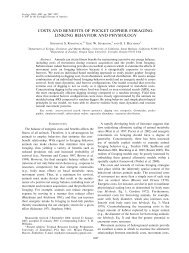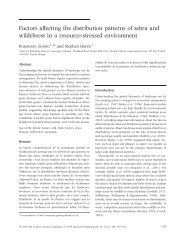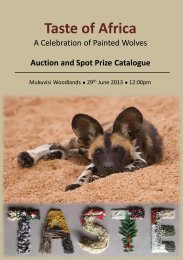The feeding ecology of the aardvark Orycteropus afer - ResearchGate
The feeding ecology of the aardvark Orycteropus afer - ResearchGate
The feeding ecology of the aardvark Orycteropus afer - ResearchGate
Create successful ePaper yourself
Turn your PDF publications into a flip-book with our unique Google optimized e-Paper software.
142 W. A. TAYLOR ET AL.Table 3. Analysis <strong>of</strong> similarity (ANOSIM) <strong>of</strong> <strong>the</strong> faecal prey communities forwinter and summer seasons from 1996 to 1998Tests for differences between seasons (averaged across all year groups)Sample statistic (Global R): 0)318Number <strong>of</strong> permutations: 5000Number <strong>of</strong> permuted statistics greater than or equal to global R: 0Significance level <strong>of</strong> sample statistic: 0Tests for differences between years (averaged across all season groups)Sample statistic (Global R): 0)124Number <strong>of</strong> permutations: 5000Number <strong>of</strong> permuted statistics greater than or equal to global R: 2Significance level <strong>of</strong> sample statistic: 0)001Pairwise testsGroups Number Number greater Significanceused permutations than stat value level1996, 1997 5000 55 0)0111996, 1998 5000 8 0)0021997, 1998 5000 31 0)006observed mound feeds in a month by <strong>the</strong> total observation time (hours) for <strong>the</strong> sameperiod.Predation frequencies were higher in winter than summer. Randomization showedstrong evidence <strong>of</strong> variation between months, but not between <strong>aardvark</strong>s (two-way-ANOVA randomized: between months p"0)001; between <strong>aardvark</strong>s p"0)65). <strong>The</strong>relationship between monthly predation frequencies and monthly <strong>feeding</strong> bout lengthsfrom epigeal mounds was tested using a Spearman rank correlation coefficient(Aardvark M5: r"0)50, n"8, p"0)21; Aardvark F4: r"!0)357, n"7, p"0)43).<strong>The</strong>re was no correlation, <strong>the</strong>refore, no association between <strong>feeding</strong> frequency and feedlength.Table 6 shows counts and percentages <strong>of</strong> <strong>the</strong> different categories <strong>of</strong> T. trinervoidesmounds determined from <strong>the</strong> sample grids, as well as <strong>the</strong> observed counts <strong>of</strong>predation on <strong>the</strong>se mounds by <strong>the</strong> habituated <strong>aardvark</strong>s. Small mounds were mostnumerous followed by medium <strong>the</strong>n large mounds. Moreover, more undug moundswere available than predug mounds. Large mounds were fed on more <strong>of</strong>ten thanexpected (χ 2 "46, df."2, p(0)001), as were predug mounds (χ 2 "683)3, df."1,p(0)001). Expected frequencies were calculated by comparing <strong>the</strong> number <strong>of</strong> termitemounds present (grids) with <strong>the</strong> number <strong>of</strong> mounds eaten.Aardvark M5 fed for an average <strong>of</strong> 177 (199), 370 (385) and 353 (362) s from small,medium and large mounds respectively, while <strong>aardvark</strong> F4 fed for an average <strong>of</strong> 111(135), 233 (303) and 242 (268) s (standard deviations in paren<strong>the</strong>ses). Small moundswere fed on for significantly shorter periods than <strong>the</strong> o<strong>the</strong>r mounds (ANOVA: F"12)5,df."2, p(0)001) (Log 10 transformation: variance'mean).Aardvark M5 fed for an average <strong>of</strong> 324 (316) and 359 (416) s from undug and predugmounds respectively, while <strong>aardvark</strong> F4 fed for an average <strong>of</strong> 322 (349) and 205 (232) s.<strong>The</strong>re were no significant differences between <strong>the</strong> length <strong>of</strong> average <strong>feeding</strong> boutson undug and predug mounds (ANOVA: F"0)2, df."1, p"0)64) (Log 10 transformation).





